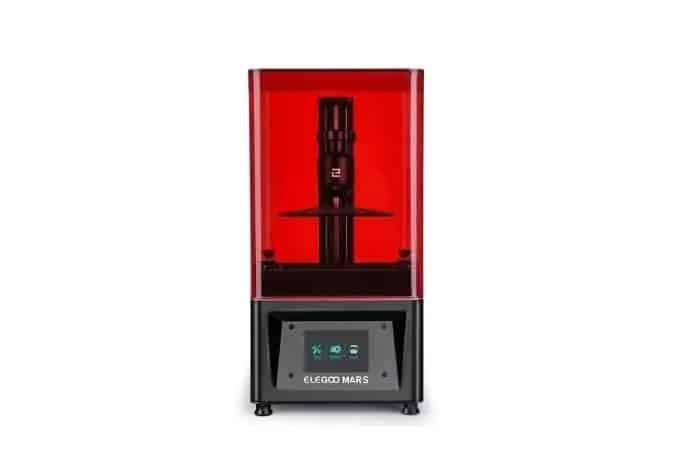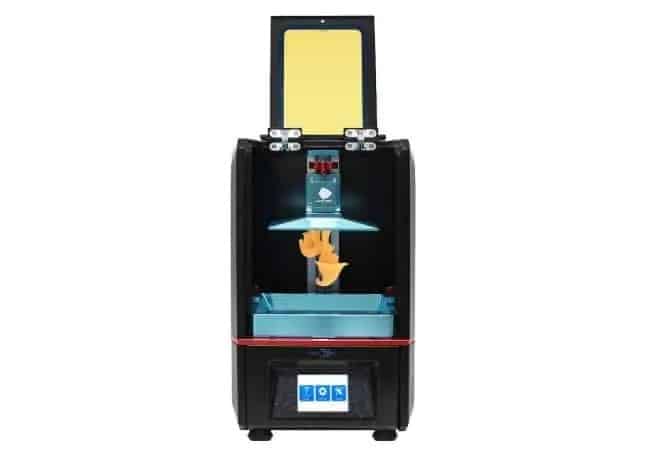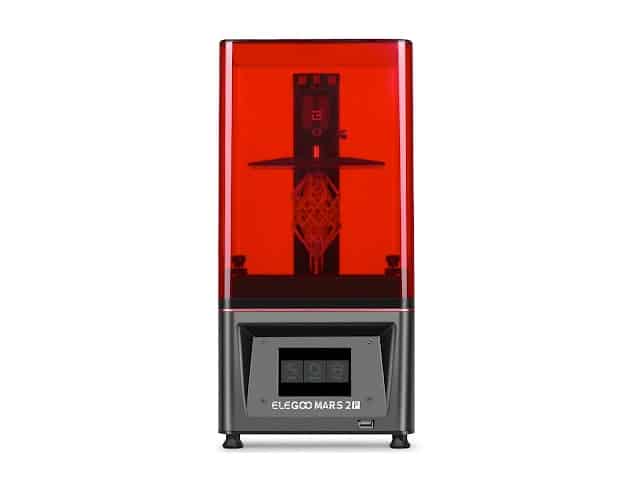If you’re looking for a 3D printer that uses resin rather than filament, you may be looking at a DLP printer as opposed to an FDM machine.
The Elegoo Mars and the Anycubic Photon are both really great, affordable options.
They each have their own advantages, so let’s dive into the differences and a comprehensive review so you’ll know which one is best for you.
Bottom Line Up Front Summary: If you want to be able to create customized, high quality, and complex prints, buy the Anycubic Photon here. For everyone else focused on affordabilty, go with the Elegoo Mars here for the best value in class.
Main Differences Between Elegoo Mars vs Anycubic Photon
The main difference between Elegoo Mars vs Anycubic Photon are:
- Elegoo Mars requires you to install the build plate yourself, whereas Anycubic Photon comes fully assembled
- Elegoo Mars does not come with a bottle of resin, whereas Anycubic Photon does.
- Elegoo Mars comes with ChiTu Box software, whereas Anycubic Photon comes with proprietary software.
We love the Anycubic Photon | Amazon
Dead simple to set-up, comes pre-assembled, intuitive touch-screen and exceptional level of detail. This machine empowers CREATORS, without expecting you to be a mechanic. The small – but precise – print bed is perfect for miniatures.
Buy at Amazon.com
Buy directly at Anycubic

The Elegoo Mars offers an easy 3D printing experience that’s great for beginners. It’s forgiving and rewarding at a great price point so you can enjoy consistent successful prints, high-quality performance, and little effort.
Technology
The reason the Elegoo Mars is so easy to use is that it features masked stereolithography technology rather than the fussy fused deposition modeling of other 3D printer varieties.
3D resin printing isn’t for everyone and the cleanup process can be quite messy. It involves washing finished pieces with ethanol, allowing them to cure, and cleaning off the build plate. Not to mention, the smell of the resin is quite powerful. However, as far as 3D resin printers go, this is one of the easier ones to maneuver.
It uses a viscous liquid resin that oozes more smoothly across a resin vat, a single moving axis that moves at a quiet whirr, and no filament wrangling. Because there are no hot ends or nozzles, there’s no drama.
The build plate itself moves layer by layer rather than two axes moving simultaneously, cutting out the noise and making it much easier to operate and maintain. While the stereolithography is simple, it makes the entire process easier. Beginners enjoy a clean experience while even experienced users will appreciate the lack of unnecessary bloat.
In addition, this technology prints great. The ratio of price to performance is much better than most other 3D printers, putting it in a class all its own.
The unit is well balanced without being too heavy. You can slide it easily if you need to, which may be more often than you like because of poor USB port placement at the rear of the machine.
Even if you have to slide it forward, it will resist tipping or rocking, so you can navigate the machine for general use without worrying.
There is a removable UV-blocking lid that can be inconvenient. You have to remove it completely to access the resin and print vat. However, over time, you’ll find that there’s clearance around the Z-axis to allow for you to get it on and off quickly.
With the lid out of the way, you get unrestricted access to your resin tank and you don’t have to remove the vat at all. Removing prints is also much easier on this printer than on many others.
The print volume is 120mm x 68mm x 155mm, so it’s a little smaller than some others, but for the price, it’s well worth sacrificing a little. It’s one of the cheapest 3D printers out there.
Why Go with the Elegoo Mars? | MatterHackers
The Elegoo Mars is great for beginners. It’s forgiving and rewarding at a great price point so you can enjoy consistent successful prints, high-quality performance, and little effort. UPDATE: The new Mars 2 Pro Mono is even better, with built in air purifier, resin printer, and FASTER print speeds.
Elegoo Mars Setup
The Elegoo Mars comes with complete instructions, but it really doesn’t need them. Just loosen two screws, lower the plate into the bottom, and level. It takes about two minutes to set up, plugin, and print.
Printing
While the printer doesn’t come with any resin, it’s compatible with any 405nm UV sensitive resins. The company also offers plenty of options that you can order directly from them so you can test them out.
Resin printing has a lot less drama than traditional filament printing, and it prints as expected without much fuss, even on the default settings without any tweaking. If you do want to fiddle with the settings a bit, you can adjust layer heights and it won’t result in failures out of the gate.
The standard layer heights of 0.01-0.02 are perfect and not worth changing. Your prints will finish with much more detail than a similarly priced FDM printer. You can boost printing ability using the included ChiTu Box slicing software, and adjusting the anti-aliasing print settings.

In most cases on an LCD printer like the Elegoo Mars, you can see a grid pattern on the surface of the print job. That’s because every slice of your print is a 2D grid made of square pixels. The pixels are realized in 3D, called voxels.
When printed, these voxels are visible. When the voxels are small enough, they are invisible in the final print job. By using the anti-aliasing settings, you can lessen this aesthetic effect. It bridges sharp corners you would normally find in the voxels.
This technique is likely more useful in larger layer heights. It can help preserve detail while still maintaining speed. You generally wouldn’t need it at small layer heights because they’re already capable of smoothing out your finish without it.
Elegoo Mars Software
The ChiTu firmware and ChiTu Box software offer a contemporary combination that’s super easy to use. Perhaps the best thing about the Elegoo Mars is that it doesn’t use proprietary software, so you can streamline your workflow, making printing prep and the machine itself pretty straightforward.
It includes all of the main features you need for printing including the two most important: model hollowing and robust support generation. You can also take advantage of other user-friendly things that allow you to make adjustments without wrecking the whole job.
Out of the box, the Elegoo Mars offers a single-program solution that is more than capable of doing anything you need it to do. You can even reposition your model without deleting supports.
Pros:
- Minimal setup
- Fantastic print quality
- Simple to use
- Affordable
Cons:
- The USB port is inconveniently located
- Prolonged use may cause firmware malfunctions
- Loud fan
The Verdict on Elegoo Mars
If you’ve been thinking about buying a resin printer but you’re on a budget or unsure of which one to get, the Elegoo Mars is a great option. For the price, you won’t waste your money and you’ll still get an incredible printer that performs just as well as some of the higher-priced models.
It’s easy to use so it’s perfect for beginners, and the software makes the experience even better.

While resin printers offer excellent print quality and ease of use that often far surpass that of an FDM printer, Anycubic offers a solution that does all of this at the same low price point. It has a bit of a learning curve, but nothing that’s not worth mastering to reap the benefits.
Anycubic Photon Features
The Anycubic Photon is another desktop DLP 3D printer that uses liquid resins cured by UV or laser rather than the traditional filament used by FDM printers. The DLP stands for Digital Light Processing, and it involves a process in which the entire image of your print job is cured with light, layer by layer.
Once your layer is resin is cured, the build plate moves up accordingly and the machine prints the next layer. One benefit of this method is a high level of accuracy and detail. The screen resolution on the Photon is 2K, which is great for the low price point.
Build volume is 115mm x 65mm x 155mm, so it’s slightly smaller than the Elegoo Mars. However, it’s a great way to experiment with this type of printing technology without spending your life savings.
The Anycubic Photon features a carbon filter with a fan, to eliminate some of the powerful resin smell, but it can still be quite strong at times. You should always wear a mask and gloves when pouring resin. A large room with open windows won’t hurt either. (Here Check Out the Full Reviews for Anycubic Kossel Delta and Anycubic i3 Mega Review before the final decision!)
We love the Anycubic Photon | Amazon
Dead simple to set-up, comes pre-assembled, intuitive touch-screen and exceptional level of detail. This machine empowers CREATORS, without expecting you to be a mechanic. The small – but precise – print bed is perfect for miniatures.
Buy at Amazon.com
Buy directly at Anycubic
Anycubic Photon Setup
Luckily, the entire machine comes pre-assembled. You’ll find everything you need including the printer, power cable, owner’s manual, resin tank, gloves and maks, a bottle of resin to start, filters, and an 8GB USB flash drive.
This USB drive has a few pre-sliced models for you to try. Already, the Anycubic Photon beats out the Elegoo Mars by coming fully assembled, including the build plate, throwing in a bottle of resin, and offering a few test models to get you started.
It may come fully assembled (except for a tiny little knob you need to screw on to the door), but that doesn’t mean it’s ready to print just yet. You need to open the cover to make sure the screen and platform are free of dust. Now you can plug it in and level it. Just remove the resin tank, use the touchscreen to start the leveling process, and then tweak the platform to level it the way you need it.
This leveling process is very similar to how an FDM printer gets manually calibrated, so if you’re familiar with doing that, you’ll have no trouble getting this one leveled perfectly. If you don’t know what you’re doing quite yet, lower the platform slowly to make it easier.
Now you can pour the resin in the vat and be on your way to printing.
Printing
To get started, use a test print job included on the USB stick. The lattice cube is a great way to demonstrate how the Anycubic Photon works. It has plenty of intricate layers that will show off the print quality and give you a better idea of how your jobs will turn out.
Because the design is already sliced and uploaded, you don’t have to familiarize yourself with the software just yet. It’s a great way to take it one step at a time, making sure your print jobs will stick to the bed. If they don’t, you may need to relevel and try again.
The print quality is impressive and the surface of the final item is smooth with intricate details. After cleaning and allowing to cure in the sun, you’ll have a solid print with a flawless exterior.
Simple designs have a virtually layerless look, which is indicative of an extremely high-quality printer. Complex projects may require a few more support structures, but you can generate those automatically and slice them in. Once the job is done, you can snip these support structures off easily.
Software
The Anycubic Photon has proprietary slicing software, so you won’t find any other manufacturers that feature the same program. However, it’s very simple to use, so you shouldn’t have any trouble, even if you’ve never used it before.
Leaving the default settings intact is your best bet if you’re unfamiliar with how to modify anything. These settings are defined well and should still result in high-quality prints. However, you can change normal exposure time, bottom exposure time, layer thickness, bottom layers, and off time.
Where the Anycubic Photon really shines is support generation. You can auto-generate supports or manually insert them wherever you need them, giving you more control over your prints.
While you have control over the placement, shape, length, radius, and density, the auto-generated supports are sufficient enough for most jobs.
You also have a variety of ways you can scale, rotate, and view your model using the slicer software. Slicing is quick and creates a Photon file you can use exclusively with this printer. While the software itself is lacking in design, it does give explanations for how to perform all of your necessary tasks and seems to be relatively easy to use.
Pros:
- Affordable
- Easy to set up and use
- Compact size
- Custom slicer with support generation
Cons:
- Small build volume
- Jobs will sometimes not stick to print bed
- Not as much customization
The Verdict: Elegoo Mars or Anycubic Photon?
The Anycubic Photon requires a bit more work to get it level and to make sure that the prints stick to the bed, but once you have it figured out, it produces very high-quality jobs. You can manually create supports if the already incredible auto-generated supports aren’t sufficient.
The proprietary slicing software produces files that you can only use on this printer, so the files are not interchangeable. However, the software is very easy to use, even for beginners. While you can’t change a lot of settings, it’s a good solution for beginners.
FAQs About 3D Printers
Is a 3D printer worth buying?
If you’re looking to print the periodic project, a DLP 3D printer is a much more cost-effective option than purchasing a traditional FDM 3D printer that uses filament. DLP 3D printers are a bit smaller, so they won’t take up as much room, and they’re a lot cheaper.
Does Elegoo Mars come with resin?
While the Elegoo Mars prints with resin, it doesn’t come with any, so you’ll have to get your own before printing. However, you can order some online from many different retailers, and you can even order it separately from Elegoo when you order your printer.
Is the Anycubic Photon worth it?
What you’ll find with the Anycubic Photon is that it prints very high-quality results at a very low price. It’s affordable, and definitely worth it whether you’re printing seldom or often. There’s a bit of a learning curve, but it’s easy to use.
Which One is Right for You?
Your experience with the Elegoo Mars will be nearly flawless. After long stretches of printing, you may find that the firmware tends to trip up on a new print. However, you can turn it off and back on again to clear the issue.
It’s a fantastic solution for beginners and experienced printers who want an insanely affordable and easy to use system that comes with the ChiTu Box software. It allows you to use the fantastic default settings or customize many of the things you may need to get a better job.
The Anycubic Photon comes with proprietary software that’s also very easy to use and comes with great default settings. You can’t customize as much, but this is great for beginners who don’t know much about how to change the settings.
It’s still an affordable solution that produces great print quality. There’s a bit more of a learning curve on the Photon, but you’ll eventually plateau and want more features and customized options that you won’t get with this one.
If you want something that’s affordable and has a third party software that’s easy to customize and use, get the Elegoo Mars. If you’d rather get something that allows you to customize your supports for high quality, complex print jobs, get the Anycubic Photon.
Bottom Line Summary: If you want to be able to create customized, high quality, and complex prints, buy the Anycubic Photon here. For everyone else focused on affordabilty, go with the Elegoo Mars here for the best value in class.
We love the Anycubic Photon | Amazon
Dead simple to set-up, comes pre-assembled, intuitive touch-screen and exceptional level of detail. This machine empowers CREATORS, without expecting you to be a mechanic. The small – but precise – print bed is perfect for miniatures.
Buy at Amazon.com
Buy directly at Anycubic
Further Reading 3D Print, 3D Resin Printer, and SLA Printer Options:




Recent Comments